Island Stories:
![]() Danzig
Mine
Danzig
Mine
![]() Zeballos
Iron Mine
Zeballos
Iron Mine
![]() Conuma
Peak 1910
Conuma
Peak 1910
Alexandra Peak
Argus Mountain
Bate/Alava Sanctuary
Beaufort Range
Big Interior Mtn
Big Interior Mtn 1913
Part 1
Part 2
Bolton Expedition 1896
Cliffe Glacier
Clinton Wood
Comox Glacier
Comox Glacier 1922
Comox Glacier 1925
Comstock Mtn
Conuma Peak
Copper King Mine
Crown Mtn
Elkhorn 1912
Elkhorn 1949
Elkhorn 1968
Eugene Croteau
Golden Bullets
Golden Hinde 1913/14
Golden Hinde 1937
Golden Hinde 1983
Harry Winstone Tragedy
Jack Mitchell
Jim Mitchell Tragedy
John Buttle
Judges Route
Koksilah's Silver Mine
Landslide Lake
Mackenzie Range
Malaspina Peak
Mariner Mtn
Marjories Load
Matchlee Mountain
Mount McQuillan
Mt. Albert Edward
Mt. Albert Edward 1927
Mt. Albert Edward 1938
Mt. Becher
Mt. Benson 1913
Mt. Benson
Mt. Doogie Dowler
Mt. Colonel Foster
Mt. Hayes/Thistle Claim
Mt. Maxwell
Mt. Sicker
Mt. Tzouhalem
Mt. Whymper
Muqin/Brooks Peninsula
Nine Peaks
Queneesh
Ralph Rosseau 1947
Rosseau Chalet
Ralph Rosseau Tragedy
Rambler Peak
Red Pillar
Rex Gibson Tragedy
Sid's Cabin
Steamboat Mtn
Strathcona Park 1980's
The Misthorns
The Unwild Side
Victoria Peak
Waterloo Mountain 1865
Wheaton Hut/Marble Meadows
William DeVoe
Woss Lake
You Creek Mine
Zeballos Peak
Other Stories:
Sierra
de los Tuxtlas
Antarctica
Cerro del Tepozteco
Citlaltepetl
Huascaran
Mt. Roraima
Nevada Alpamayo
Nevada del Tolima
Nevado de Toluca
Pico Bolivar
Popocatepetl
Uluru/Ayers Rock
Volcan Purace
Volcan San Jose
Biographies
Island 6000
Cartoons
Order the Book
Contact Me
Links

Alexandra
Peak:
A Royal Danish Consort
by Lindsay Elms
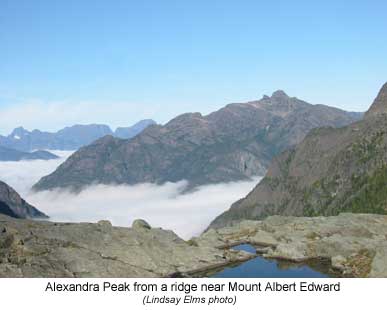 Alexandra
Peak, at the head of the Oyster River, is named after Princess Alexandra,
the eldest daughter of King Christian IX of Denmark. She became the Princess
of Wales in March 1863 when she married Queen Victoria's son Prince Albert
Edward, and then Queen Alexandra in 1901 when King Edward VII ascended
the throne of England.
Alexandra
Peak, at the head of the Oyster River, is named after Princess Alexandra,
the eldest daughter of King Christian IX of Denmark. She became the Princess
of Wales in March 1863 when she married Queen Victoria's son Prince Albert
Edward, and then Queen Alexandra in 1901 when King Edward VII ascended
the throne of England.
From the Comox Argus August 14, 1930
Mountaineering
Mr. W.A. [Adrian] B. Paul who has done so much to explore the alpine beyond the Forbidden Plateau has put mountaineers still further in debt by climbing Alexandra Peak from Circle [Circlet] Lake and exploring the country in between. He took with him David Guthrie and Henry Ellis. They rode as far as Croteau's camp and made their base at Circle Lake. It took them four days to get to and climb Alexandra Peak, but Mr. Paul thinks that with his experience, he could now make it in three days. The chief difficulty was in getting in and out of the Oyster valley and its stark bluffs. There is some very fine views and country, and for quite a little of the distance a horse can be taken. There are two peaks at Alexandra, one smaller and one greater.
The Thumb is Difficult
The smaller is the thumb and the larger like the doubled fist. The smaller
is so steep and difficult as [Mount] Arrowsmith with quite a little rock
work but there are good handholds. It can only be climbed from this side,
on two other sides it is sheer and on the other side it overhangs. The
bigger peak is not difficult. From the top of Alexandra a wide vista of
the glaciers and peaks of Buttles Lake reveals itself. Many very interesting
peaks and alpine country come into view that are very tempting for the
explorer. The top of one peak looks like a tennis court, so level is it
forming the top of a very steep mountain. Gradually as climbers penetrate
into this country trails will be mapped out. The pioneer always has to
do the hard climbing and the hard work for others to follow: but his is
the joy of penetrating into virgin territory.
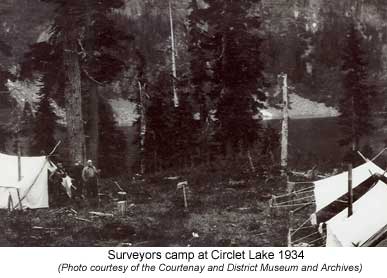 Addendum:
Addendum:
by Lindsay Elms
After Adrian Paul and his party's ascent in 1930, the surveyor Leroy
Cokely set up a station on what he called the "hump"
on Alexandra Peak. Then on July 11, 1934 the surveyor Norman
Stewart, along with packers Dick Williams and Dan Harris
climbed the peak in wet, foggy conditions, however, they left their instruments
at the timberline. Two days later Stewart and William's were back on the
summit only this time they were able to take some readings but no photographs.
Stewart returned again on July 17 and 18 to obtain more readings and that
was followed by three days of rain. Finally on the 22nd and 23rd Stewart
took his last readings from the two summit stations (Alexandra NE and
SE) before heading back to Circlet Lake. However, while on the summit
of Alexandra Peak on the 23rd Stewart was able to see William
Moffat, another surveyor, on the summit of Mount
Albert Edward.
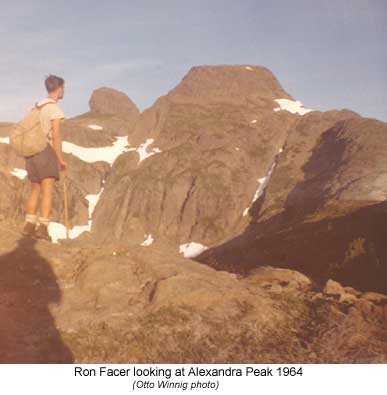 |
 |
|
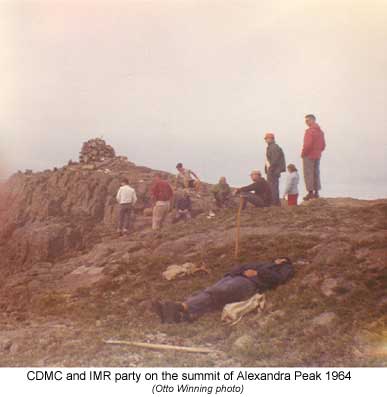 |
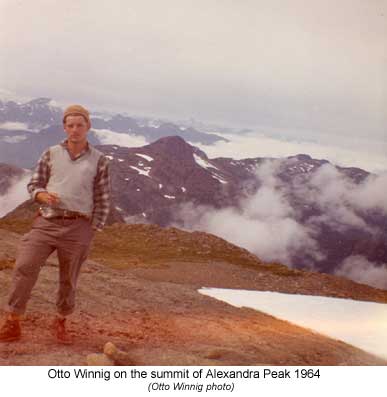 |
How to order | | About the Author || Links || Home
Contact:
Copyright ©
Lindsay Elms 2001. All Rights Reserved.
URL: http://www.beyondnootka.com
http://www.lindsayelms.ca